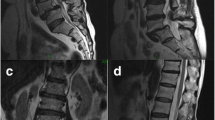Abstract
Purpose
We aimed to determine the age- and sex-related changes in facet orientation and facet tropism in lower lumbar spine.
Methods
Between June 2015 and December 2017, magnetic resonance imaging scans of the consecutive 600 patients performed in the outpatient department for low back pain were analyzed. The data were divided according to age into four groups: group A (< 30 years), group B (31–45 years), group C (46–60 years) and group D (> 60 years). The orientation of the facet angles at L3–4, L4–5 and L5–S1 was measured using the method described by Noren et al. Sagittal angles and tropism were determined at each level.
Results
Average facet angle is noted to increase from L3–4 to L5–S1 level in all groups irrespective of age and sex. A positive correlation is noted between age and sagittal facet orientation at all levels across all groups. Tropism was noted to be statistically significant (p < 0.05) at L5–S1 level. L3–4 and L4–5 levels did not show a positive correlation with respect to age. Facet angle sagittalization was significantly associated in males at L5–S1 level (p < 0.05) and in females at L4–5 level (p < 0.05).
Conclusions
Predominant morphological changes in superior articular process are responsible for remodeling of facets that occur with increasing age, resulting in sagittalization. Even though the facet orientation changes over a period of time, differential changes within the facets at the same level might not be seen.
Graphical abstract
These slides can be retrieved under Electronic Supplementary Material.




Similar content being viewed by others
References
Farfan HF, Sullivan JD (1987) The relation of facet orientation to intervertebral disc failure. Can J Surg 10:179–185
Cyron BM, Hutton WC (1980) Articular tropism and stability of the lumbar spine. Spine 5:168–172
Boden SD, Riew KD, Yamaguchi K, Branch TP, Wiesel SW (1996) Orientation of the lumbar facet joints: association with degenerative disc disease. J Bone Joint Surg Am 78:403–411
Grobler LJ, Robertson PA, Novotny JE, Pope MM (1993) Etiology of spondylolisthesis: assessment of the role played by lumbar facet joint morphology. Spine 18:80–91
Kim NH, Lee JW (1995) The relationship between isthmic and degenerative spondylolisthesis and the configuration of the lamina and facet joints. Eur Spine J 4:139–144
Grannum S et al (2015) Risk factors for the development of a mobile degenerative spondylolisthesis at L4–L5. Spine Deform 3:98–104
Noren R, Trafimow J, Andersson GB, Huckman MS (1991) The role of facet joint tropism and facet angle in disc degeneration. Spine 16:530–532
Chadha M et al (2013) Association of facet tropism with lumbar disc herniation. Eur Spine J 22:1045–1052
Samartzis D, Cheung JP et al (2016) Critical values of facet joint angulation and tropism in the development of lumbar degenerative spondylolisthesis: an international, large-scale multicenter study by the AO Spine Asia Pacific research collaboration consortium. Glob Spine J 5:414–421
Boos N, Weissbach S, Rohrbach H et al (2002) Classification of age-related changes in lumbar intervertebral discs: 2002 Volvo award in basic science. Spine 27:2631–2644
Vanharanta H, Floyd T, Ohnmeiss DD, Hochschuler SH, Guyer RD (1993) The relationship of facet tropism to degenerative disc disease. Spine 18:1000–1005
Adams MA, Hutton WC (1981) The relevance of torsion to the mechanical derangement of the lumbar spine. Spine 6:241–248
Lorenz M, Patwardhan A, Vanderby R Jr (1983) Load-bearing characteristics of lumbar facets in normal and surgically altered spinal segments. Spine (Phila Pa 1976) 8:122–130
Yang KH, King AI (1984) Mechanism of facet load transmission as a hypothesis for low-back pain. Spine (Phila Pa 1976) 9:557–565
Van Schaik JP, Verbiest H, Van Schaik FD (1985) The orientation of laminae and facet joints in the lower lumbar spine. Spine 10(1):59–63
Dunlop RB, Adams MA, Hutton WC (1984) Disc space narrowing and the lumbar facet joints. J Bone Joint Surg Br 66:706–710
Benoist M (2003) Natural history of the aging spine. Eur Spine J 12(suppl 2):S86–S89
Ingalhalikar VT (2003) Understanding spinal instability. Indian J Orthop 37:2
Jaumard NV, Welch WC, Winkelstein BA (2011) Spinal facet joint biomechanics and mechano transduction in normal, injury and degenerative conditions. J Biomech Eng 133:071010-1
Fujiwara A, Tamai K, An HS et al (2001) Orientation and osteoarthritis of the lumbar facet joint. Clin Orthop Relat Res 385:88–94
Wang J, Yang X (2009) Age-related changes in the orientation of lumbar facet joints. Spine 34(17):596–598
Love TW, Fagan AB, Fraser RD (1999) Degenerative spondylolisthesis. Developmental or acquired? J Bone Joint Surg Br 81:670–674
Author information
Authors and Affiliations
Corresponding author
Ethics declarations
Conflict of interest
The authors declare that they have no conflict of interest
Additional information
Publisher's Note
Springer Nature remains neutral with regard to jurisdictional claims in published maps and institutional affiliations.
Electronic supplementary material
Below is the link to the electronic supplementary material.
Rights and permissions
About this article
Cite this article
Degulmadi, D., Dave, B.R. & Krishnan, A. Age- and sex-related changes in facet orientation and tropism in lower lumbar spine: an MRI study of 600 patients. Eur Spine J 28, 961–966 (2019). https://doi.org/10.1007/s00586-019-05953-y
Received:
Revised:
Accepted:
Published:
Issue Date:
DOI: https://doi.org/10.1007/s00586-019-05953-y




